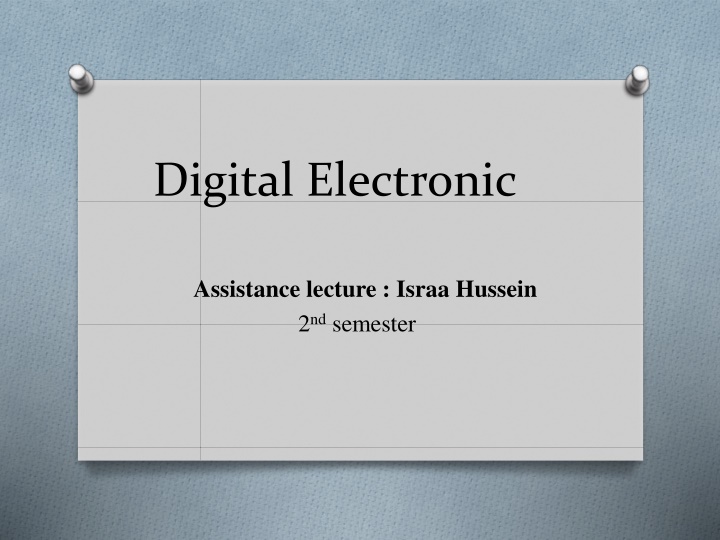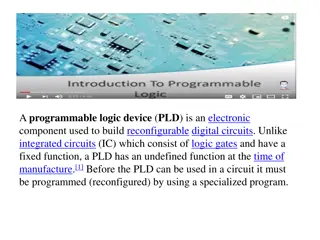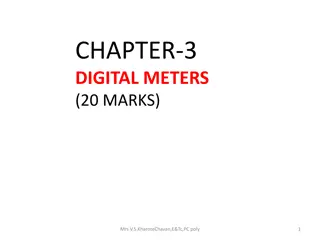Digital Electronic
In this digital electronic assistance lecture by Israa Hussein, the focus is on the hexadecimal numeration system, its place-weighted nature, and how to convert binary numbers to hexadecimal. The lecture covers the equivalence between decimal, binary, octal, and hexadecimal systems, providing clear examples and explanations for better understanding. It also delves into the conversion methods between different numeration systems, such as binary, decimal, octal, and hexadecimal, showcasing the practical applications and significance of these conversions in electronic circuits and digital systems.
Download Presentation

Please find below an Image/Link to download the presentation.
The content on the website is provided AS IS for your information and personal use only. It may not be sold, licensed, or shared on other websites without obtaining consent from the author.If you encounter any issues during the download, it is possible that the publisher has removed the file from their server.
You are allowed to download the files provided on this website for personal or commercial use, subject to the condition that they are used lawfully. All files are the property of their respective owners.
The content on the website is provided AS IS for your information and personal use only. It may not be sold, licensed, or shared on other websites without obtaining consent from the author.
E N D
Presentation Transcript
Digital Electronic Assistance lecture : Israa Hussein 2ndsemester
Chapter One Lecture 3 2
1.3.5 Hexadecimal numeration system: The hexadecimal numeration system is a place weighted system with a base of sixteen. Valid ciphers include the normal decimal symbols 0 , 1 , 2 , 3 , 4 , 5 , 6 , 7 ; 8 ;9 Plus six alphabetical characters A, B, C, D, E, and F. To convert from binary to hexadecimal numeration, we group bits in fours. Each group of four bit is replaced by its hexadecimal equivalent. The following table summarizes the equivalence between decimal, binary, octal and hexadecimal systems. 3
Decimal 0 1 2 3 4 5 6 7 8 9 10 11 12 13 14 15 Binary 0000 0001 0010 0011 0100 0101 0110 0111 1000 1001 1010 1011 1100 1101 1110 1111 Octal 0 1 2 3 4 5 6 7 10 11 12 13 14 15 16 17 Hexadecimal 0 1 2 3 4 5 6 7 8 9 A B C D E F 4
Example 1.6: Convert the following binary numbers in hexadecimal? A = 1101011101 B = 11101011101.11 Solution : As explained above, We just have to group the binary number in groups of four bits each: 5
As explained above, we just have to group the binary number in groups of four bits each: The binary number has been grouped is groups of four bits each, from the right to the left two implied zeros have been added at the extreme left. In the same way the number B can also be converted. 6
Changing of base: We have already seen in the previous section how to change from binary to decimal, octal or hexadecimal systems of numeration. The present section is intended to show how to move from a given system of numeration to any other system. From octal and hexadecimal to binary and decimal: The octal and hexadecimal systems are actually used by computer engineers just to obtain a shorthand representation of binary numbers (because octal and hexadecimal representations take a few numbers of ciphers or symbols as compared to the binary system). Only binary system is implemented in the electronic circuits of digital systems (through two levels of voltages or currents: high (1) and low (0)), the other systems being used by engineers just for simplification issues. However, we sometimes have the need to convert either of those systems to binary or decimal forms. 7
Octal and hexadecimal to binary: It is obvious that to convert from octal to binary, We must convert each octal cipher to its binary equivalent in 3 bits. In the same way, to convert from hexadecimal to binary, we should convert each hexadecimal symbol into its binary equivalent in 4 bits. 8
Example 1.7: Convert the following octal number to digital 5238. Convert the following hexadecimal number to binary 4DC216. 9
1.4.1.2 Octal to Decimal Because octal is a base of eight numeration system, each place weight value differs from either adjacent place by factor of eight. Example 1.8: Let us convert the following octal number to decimal: A = 264.748 10
Exercise 1.3: Convert the following octal number to decimal: A = 4562.368 B = 523411.2328 C= 264.3658 D = 4516328 Is the number 12586 an octal number? 11
Hexadecimal to Decimal The technique for converting hexadecimal notation to decimal is the same as the one used above, except that each successive place weight changes by a factor of sixteen. Example 1.9: Let us convert the following hexadecimal number to decimal: 12 Physics department, University of Babylon, 2018.
Exercise 1.4: Convert from hexadecimal to decimal. X = A23C.DF16 Y = 7D3E16 Z= D96EC.FA16 13























